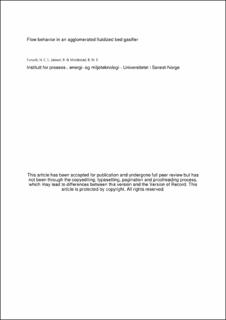| dc.contributor.author | Furuvik, Nora Cecilie Ivarsdatter | |
| dc.contributor.author | Jaiswal, Rajan | |
| dc.contributor.author | Moldestad, Britt Margrethe Emilie | |
| dc.date.accessioned | 2020-03-10T13:27:20Z | |
| dc.date.available | 2020-03-10T13:27:20Z | |
| dc.date.created | 2019-09-30T16:34:48Z | |
| dc.date.issued | 2019 | |
| dc.identifier.citation | The International Journal of Energy and Environment. 2019, 10 (2), 55-64. | en_US |
| dc.identifier.issn | 2076-2895 | |
| dc.identifier.uri | https://hdl.handle.net/11250/2646240 | |
| dc.description.abstract | The global energy demand has increased over the last decades and the need for utilization of energy produced from sustainable sources is stressed. Fluidized bed gasification of biomass is a thermochemical conversion process that involves heating and converting of biomass into a gaseous mixture of syngas. The syngas can be used for sustainable production of heat, power and biofuels for useful applications. Agglomeration of bed material due to ash melting is one of the biggest challenges associated with fluidized bed gasification of biomass. Inorganic alkali components from the biomass cause problems as they can form a sticky layer on the surface of the bed particles and make them grow towards larger agglomerates that will interfere with the fluidization process. The aim of this work was to study the effect of agglomerates on the flow behavior in a fluidized bed gasifier. The experiments were performed in a cold-flow model of a bubbling fluidized bed at ambient temperature. Three different experiments were carried out: (I) with sand particles as bed material, (II) with agglomerates located at the bottom of the bed and (III) with agglomerates located at the top of the bed. The results show that agglomerates lead to decreased pressure drop and increased minimum fluidization velocity. The minimum fluidization velocity increased from 0.035 m/s in the normal fluidized bed to 0.041 m/s in the agglomerated fluidized bed where the agglomerates were placed at the bottom of the bed. The minimum fluidization velocity increased further to 0.057 m/s in the agglomerated fluidized bed where the agglomerates where added from the top of the bed. This study also found that bed agglomeration causes channeling and poor fluidization conditions. | en_US |
| dc.language.iso | eng | en_US |
| dc.title | Flow behavior in an agglomerated fluidized bed gasifier | en_US |
| dc.type | Peer reviewed | en_US |
| dc.type | Journal article | en_US |
| dc.description.version | acceptedVersion | en_US |
| dc.source.pagenumber | 55-64 | en_US |
| dc.source.volume | 10 | en_US |
| dc.source.journal | The International Journal of Energy and Environment | en_US |
| dc.source.issue | 2 | en_US |
| dc.identifier.cristin | 1731841 | |
| dc.relation.project | Norges forskningsråd: 280892 | en_US |
| cristin.ispublished | true | |
| cristin.fulltext | postprint | |
| cristin.qualitycode | 1 | |
